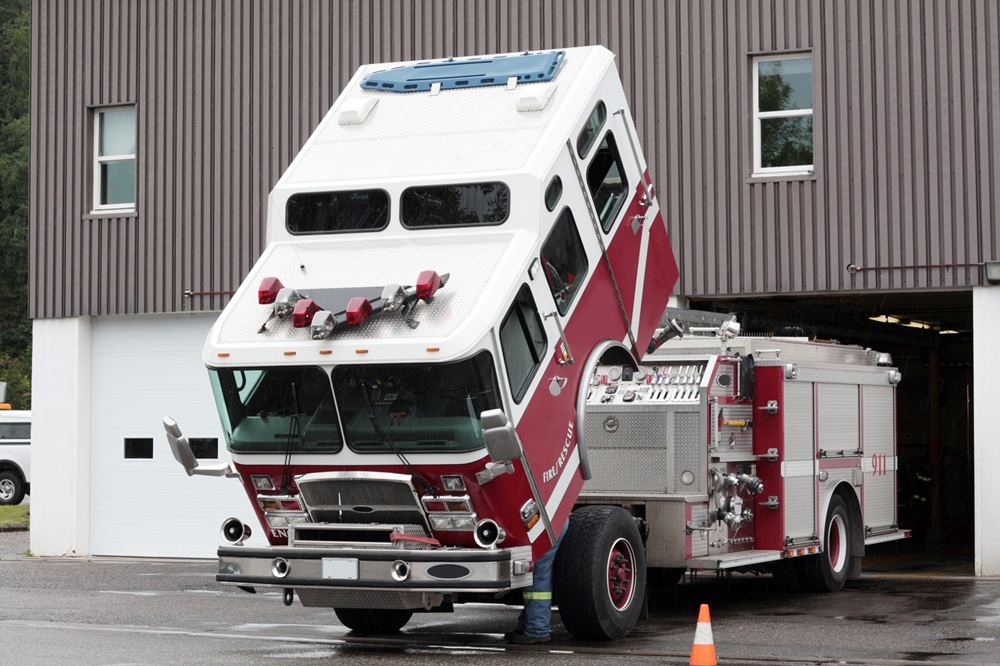
As spring arrives, so does the increased risk of wildfires, longer daylight hours, and an uptick in emergency calls. For fire departments, this seasonal shift demands a proactive approach to ensuring vehicles and equipment are ready to perform. Firefighter auto insurance plays a critical role in this effort, offering coverage that protects emergency vehicles and their operators while on duty. Deferred maintenance can lead to operational disruptions, mechanical failures, and insurance complications. As an insurance agent, you play a pivotal role in helping fire departments protect their fleets and portable gear — all while minimizing liability exposures and financial risks.
Spring Fleet Maintenance Priorities for Emergency Vehicles
As emergency call volume increases in spring, fire departments must prioritize mechanical reliability and operational readiness across their fleets.
Inspecting and Servicing Engines and Braking Systems
Engines and brakes must be in their best condition to guarantee safe, swift responses to emergencies. Encouraging departments to schedule pre-season mechanical evaluations helps avoid in-service breakdowns, which can jeopardize both lives and insurance claims.
These breakdowns can also impact firefighter auto insurance claims by complicating liability assessments and increasing repair costs. Scheduled inspections — conducted daily, weekly, monthly, and annually — should cover systems such as brakes, water pumps, and electrical components. Brake pads, rotors, and hydraulic systems should be regularly tested and maintained for peak performance.
Tire, Battery, and Fluid Checks
Winter conditions may have taken a toll on tires and batteries. Particularly during high-response months, departments should routinely monitor tire condition and pressure, replace worn tires, and check batteries for corrosion or poor performance.
Regularly checking and topping off oil, coolant, and hydraulic fluids is also essential, as neglecting these areas can lead to overheating or system failure — exposing departments to liability and hindering claim resolutions.
Updating Documentation and Maintenance Logs
Accurate maintenance records are not only best practices but also critical assets during the claims process. Incomplete logs can complicate or delay insurance payouts, especially for damage resulting from preventable issues. Fire departments should document all maintenance work and verify that personnel responsible for upkeep are adequately trained in routine checks and compliance procedures.
Equipment Risks and the Role of Portable & Mobile Equipment Coverage
Spring brings more calls and opportunities for wear, damage, or loss of portable gear, making insurance coverage a necessary safeguard.
Wear and Tear on Mobile Tools and Gear
Portable tools such as pumps, generators, and rescue gear are vital during the spring surge in emergency calls. Frequent use increases the chance of wear, malfunction, or total failure, raising safety and financial concerns.
Theft and Damage In-Transit or On-Scene
Whether transporting equipment to remote scenes or staging gear at large-scale events, departments face increased exposure to theft, vandalism, and weather-related damage. Departments that lack sufficient portable equipment or firefighter auto insurance coverage may face significant financial losses when these incidents occur.
What Insurance Should Cover
A solid portable and mobile equipment policy should address replacement costs, in-use protection, accidental damage, and loss during transit or scene operations. Coverage should also include components like hoses, nozzles, and other gear that could become damaged or lost while responding to emergencies.
Strengthening Protection With Commercial Auto Insurance
Commercial auto coverage plays a crucial role in keeping departments financially secure and operationally sound in the face of road-related risks and accident claims.
Collision, Liability, and Property Damage
Responding to emergencies increases driving risks. Fire apparatus are large, heavy vehicles that require skilled handling — especially in adverse weather or high-pressure situations. A robust commercial auto policy protects against departmental vehicles and third-party property damage.
Uninsured Motorist and Emergency Use Scenarios
Emergency vehicles traveling across jurisdictions or backing up mutual aid calls face heightened risks. Insurance must account for uninsured motorists and emergency operations to avoid costly gaps.
Claims Preparedness and Policy Review
Insurance agents should help clients verify that vehicle schedules are accurate, coverage terms are up to date, and procedures are in place for prompt claims reporting and resolution each spring. Regular training and using original equipment manufacturer parts can also strengthen claims outcomes and reduce exposure to avoidable losses.
How Insurance and Maintenance Work Together To Protect Fire Apparatus
Maintenance isn’t just about reliability — it’s a key part of a department’s broader risk-management strategy, ensuring that coverage is upheld and operations remain seamless.
By encouraging regular maintenance, agents help departments reduce avoidable mechanical failures and associated liability. When combined with tailored commercial auto and portable and mobile equipment insurance policies, departments gain well-rounded protection that maintains continuity of service and financial resilience. Reinforcing this protection with firefighter auto insurance establishes departments are equipped for everyday responses and unexpected incidents.
Contact us to help your fire department clients align their spring maintenance practices with comprehensive coverage.
About Provident FirePlus
Founded in 1902, our rich history involves the creation of custom firefighter insurance benefits in 1928. Today, Provident FirePlus continues to be a pioneer in developing insurance programs for firefighters, EMS providers, municipal entities, and law enforcement. In addition, we provide Special Risks insurance for various volunteer and nonprofit groups. Give us a call today at (855) 201-8880 to speak with one of our representatives.

